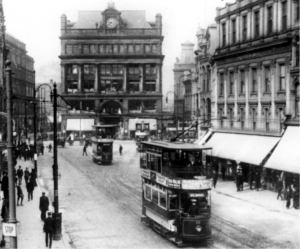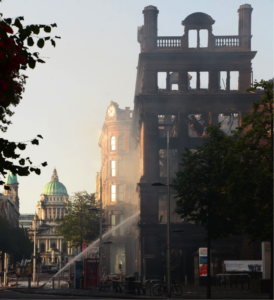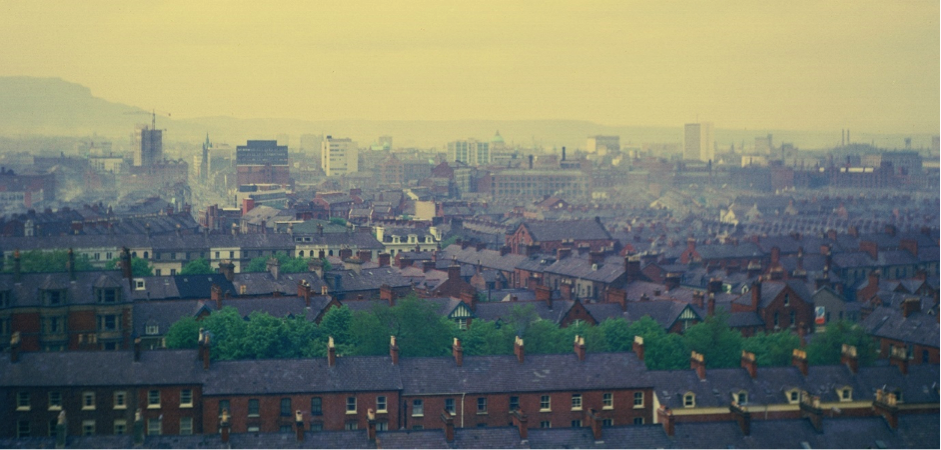“It stands erect, but gaunt, skeletal, charred and almost resentfully dominating the view it once looked proudly over.” Marcus Patton, the renowned architectural historian, poetically sums up the current condition of Belfast’s tragically destroyed Bank Buildings. While the initial standstill caused by last month’s fire is beginning to ease, there appear to be few positives that can be taken from the incident. In fact, it may be seen as crude to suggest any.
What there has been, however, is a remarkable outpouring of grief and genuine distress by many members of the public. More than anything, this highlights how buildings, and their heritage, remain vitally important for city residents.
In the hours following the blaze, thousands of Belfast natives — the majority of whom are likely to hold little more than an interest in architecture and conservation — took to social media to pay their respects to the famous site. While the general feeling of shock and disbelief quickly turned to sadness, many nostalgically recalled fond memories of the building. Not just memories of its physical appearance, but of the narrative of what the building actually meant to people. Be it a spot for family shopping at Christmas or a place of work.
And for those who may carry no interest in the issues of conservation, it would be difficult to say that their awareness of built heritage would not have been influenced in one way or another over the last few weeks. It is crucial to take advantage of this, we can’t wait for another disaster to further ignite such interest. We need to remind people, more regularly than we think, of the seriousness of actively sustaining the historic elements of our environments.
While the tram lines that once passed through the area are well gone, Castle Street and Royal Avenue remain key routes for pedestrians navigating the city centre. Designed by W.H. Lynn, Bank Buildings memorably stood as an audacious red sandstone department store. The building featured an iconic clock over a row of cast iron columns, while the ground floor was clad in polished marble. It became a landmark site within Victorian Belfast, as the city expanded faster than most Irish and UK municipalities during the 19th century.
Sadly, much damage was done to the city centre during the war, with some streets wiped out entirely. Following this, road plans in the 1960s, the Troubles and the early 2000s development frenzy, further transformed the makeup of Belfast. Consequently, what historic buildings remain are becoming ever more rare and precious. Something which makes the fire even more damning.
A historic city, it must be remembered, is not just important for tourism. It likewise attracts business and it makes a healthy and lively environment for residents. Take Edinburgh, for instance, where its architecture is renowned the world over and is a key driver for individuals and business investing in the city. In the case of Belfast, the popularity of the well preserved St. George’s Market is no coincidence — it provides the liveliness and enjoyment of city-centre living, which is often so lacking in many modern developments.
Frustratingly, the media coverage of the Bank Buildings fire appeared to particularly focus on its economic implications. What is clear from listening to members of the public, however, is that the social costs weigh just as heavy as the financial concerns. The site may remain cordoned off for months, but few citizens, or even local business owners, would call for the site to be tumbled in an attempt to ensure a quicker redevelopment and opening of the surrounding streets.
In the coming months, as attempts to restore what is left of the building begin, it is likely that scaffolding will cover the remaining facade from view. In a metaphorical sense, however, the building, and wider heritage issues, have been exposed more than ever. By boiling up emotions amongst Belfast residents, the fire has made us realise how we need buildings to explain what we have been through, what a city has endured and what it is that we enjoy about living there. While conservation is often narrowly viewed as a middle-class pastime, the fallout from the fire highlights a heightened sense of attachment to built heritage amongst vast arrays of the public. It is essential to turn this interest into action.
Practically achieving this is no easy feat, however. And what is the exact ‘action’ which is needed or ‘outcome’ which is desired? The only thing that can be said for certain, is that the demise of the Bank Buildings has changed the mentality of many people. Often, a change of mentality is the most important outcome of an event, as it shapes a mindset change in the critical consciousness of an individual. Generally, a critical mindset leads citizens to question their political surroundings and realise how they must personally intervene with reality in order to transform it.
One logical step forward, for those who haven’t already, would be to join the Save Cathedral Quarter movement. A key component of historic Belfast, the Cathedral Quarter is a highly sought after area for redevelopment. Fears continue to grow regarding the impact big business development would have upon the built heritage, housing and local economy of the community. If the movement to protect the Cathedral Quarter can be bolstered by those intrigued and captivated by the Bank Building fire, then perhaps a huge step towards fighting off the prospect of unsustainable development can be made. There is hope, then, that the darkness of last month’s fire can act as a catalyst to ensure there is no such incident again.



